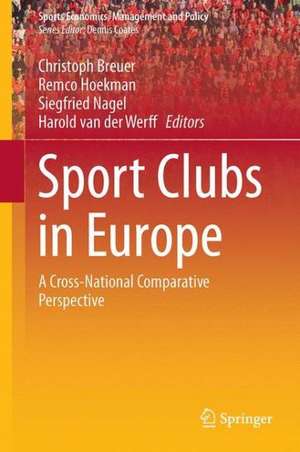Sport Clubs in Europe: A Cross-National Comparative Perspective: Sports Economics, Management and Policy, cartea 12
Editat de Christoph Breuer, Remco Hoekman, Siegfried Nagel, Harold van der Werffen Limba Engleză Hardback – 22 aug 2015
| Toate formatele și edițiile | Preț | Express |
|---|---|---|
| Paperback (1) | 846.44 lei 38-44 zile | |
| Springer International Publishing – 22 oct 2016 | 846.44 lei 38-44 zile | |
| Hardback (1) | 870.24 lei 38-44 zile | |
| Springer International Publishing – 22 aug 2015 | 870.24 lei 38-44 zile |
Din seria Sports Economics, Management and Policy
- 18%
 Preț: 956.03 lei
Preț: 956.03 lei - 15%
 Preț: 633.53 lei
Preț: 633.53 lei - 15%
 Preț: 651.84 lei
Preț: 651.84 lei - 18%
 Preț: 1001.65 lei
Preț: 1001.65 lei - 18%
 Preț: 949.55 lei
Preț: 949.55 lei - 18%
 Preț: 897.14 lei
Preț: 897.14 lei - 18%
 Preț: 892.28 lei
Preț: 892.28 lei - 15%
 Preț: 687.84 lei
Preț: 687.84 lei - 18%
 Preț: 888.49 lei
Preț: 888.49 lei - 18%
 Preț: 894.03 lei
Preț: 894.03 lei - 24%
 Preț: 889.35 lei
Preț: 889.35 lei - 18%
 Preț: 777.20 lei
Preț: 777.20 lei - 18%
 Preț: 789.03 lei
Preț: 789.03 lei - 18%
 Preț: 777.20 lei
Preț: 777.20 lei - 18%
 Preț: 1002.44 lei
Preț: 1002.44 lei - 15%
 Preț: 636.30 lei
Preț: 636.30 lei - 15%
 Preț: 695.19 lei
Preț: 695.19 lei - 15%
 Preț: 635.15 lei
Preț: 635.15 lei -
 Preț: 386.61 lei
Preț: 386.61 lei - 18%
 Preț: 953.97 lei
Preț: 953.97 lei - 15%
 Preț: 637.59 lei
Preț: 637.59 lei
Preț: 870.24 lei
Preț vechi: 1145.05 lei
-24% Nou
Puncte Express: 1305
Preț estimativ în valută:
166.54€ • 180.84$ • 139.89£
166.54€ • 180.84$ • 139.89£
Carte tipărită la comandă
Livrare economică 19-25 aprilie
Preluare comenzi: 021 569.72.76
Specificații
ISBN-13: 9783319176345
ISBN-10: 331917634X
Pagini: 250
Ilustrații: X, 435 p. 86 illus., 2 illus. in color.
Dimensiuni: 155 x 235 x 29 mm
Greutate: 1.02 kg
Ediția:1st ed. 2015
Editura: Springer International Publishing
Colecția Springer
Seria Sports Economics, Management and Policy
Locul publicării:Cham, Switzerland
ISBN-10: 331917634X
Pagini: 250
Ilustrații: X, 435 p. 86 illus., 2 illus. in color.
Dimensiuni: 155 x 235 x 29 mm
Greutate: 1.02 kg
Ediția:1st ed. 2015
Editura: Springer International Publishing
Colecția Springer
Seria Sports Economics, Management and Policy
Locul publicării:Cham, Switzerland
Public țintă
ResearchCuprins
Introduction.- Theoretical Framework.- Norway.- Sweden.- Denmark.- Spain.- Italy.- Germany.- Belgium.- The Netherlands.- Switzerland.- France.- Finland.- England.- Czech Republic.- Greece.- Hungary.- Austria.- Estonia.- Northern-Ireland.- Poland.- Slovenia.- Conclusion.- Epilogue.
Textul de pe ultima copertă
This book presents an up-to-date portrait of the characteristics of sport clubs in various European countries and their role in society and the national sport system. Furthermore, it offers a cross-national comparative perspective of sport clubs in twenty European countries. Containing both empirical data and information on the political and historical backgrounds of sport clubs, the book is organized in three parts. First, the authors provide an overview of the theoretical approach of the book and a description of the framework used for the country chapters. Second, the country chapters, written by experts within the field, provide a systematic overview of the available information on sport clubs in each country. These chapters are structured to answer the following questions: (1) What is the position of sport clubs within the national sport structure? (2) Which role do they fulfil in policy and society? (3) What are their basic characteristics and what factors influence the development of sport clubs? The book is concluded with a systematic comparison of the participating countries with the purpose of forging a clear link between the functioning of policy systems, observed problems, and possible solutions, and with a future research agenda on sport clubs. In an era of increased collaboration between European states, sport provides a natural vehicle through which to compare changes in culture, economics, and policy across nations. Sport Clubs in Europe will appeal to scholars of nonprofit management, sports management and sports sociology as well as administrators and policy makers in the international sports community.
Caracteristici
Presents an up-to-date portrait of the characteristics of sport clubs in over twenty European countries Provides a cross-national comparison of sport clubs in Europe Contains empirical data as well as information on the political and historical backgrounds of sport clubs?










